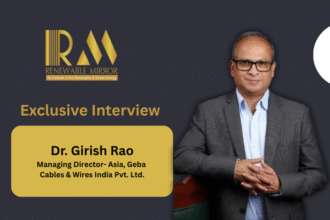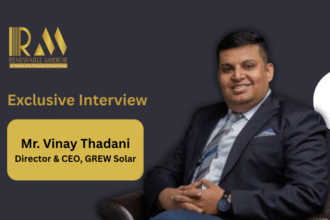Q1. Goldi Solar recently unveiled the ‘NaMo Saur Samrat’ module at the Kosamba facility on Prime Minister Modi’s 75th birthday. What was the motivation behind launching this module on such a symbolic date, and what does the company hope this new module will achieve in terms of market perception, performance, and product positioning?
As an Indian company, we wanted to mark this milestone in a way that carried both symbolic and technical weight. The NaMo Saur Samrat was presented on the Hon’ble Prime Minister’s 75th birthday with exact dimensions of 75 inches by 150 inches to reflect that significance. Designed and manufactured at our Kosamba facility in Gujarat, it delivers a capacity of 1575 Wp, making it the world’s largest solar module. Built with advanced 340 HC TOPCon cell technology, it reduces energy loss and delivers higher efficiency. This launch is meant to show that India is no longer catching up in solar manufacturing but setting new benchmarks for innovation, precision, and scale. It strengthens our position in the market while reinforcing national pride in India’s ability to lead the clean energy transition.
Q2. How has the integration of AI-powered technology in Goldi Solar’s PV module manufacturing improved both production efficiency and product quality?
Goldi Solar has invested in India’s first AI and AOI-powered manufacturing line, which has transformed the way modules are produced. The advanced integrated machine runs at a throughput of 10,000 cells per hour, the highest in India, enabling faster production without compromising quality. Real-time AI-enabled inspection systems detect even the smallest imperfections, which reduces waste, lowers rejection rates, and ensures modules meet stringent performance standards. The entire line, from automated EVA laying to intelligent sorting and live monitoring through MES systems, creates a seamless process that improves consistency and reliability. This allows us to deliver modules that perform well not only in controlled testing but also in real-world installations, including projects like the full electrification of Chikhalda village.
Q3. How does participation in REI 2025 align with Goldi Solar’s strategic objectives and support its growth and expansion within India’s renewable energy sector?
For us, REI 2025 is an important opportunity to place Goldi’s innovations before the clean energy community at Asia’s premier industry platform. It gives us the space to showcase the NaMo Saur Samrat module and our AI-powered manufacturing capabilities to decision-makers from across India and abroad. It also allows us to compare ourselves with leading global players and engage with government representatives, investors, EPCs, and developers who are shaping the sector’s future. By being present at REI, we strengthen our brand visibility and open doors to partnerships that can help us scale our capacity, expand our reach, and align more closely with India’s renewable energy growth targets.
Q4. What is Goldi Solar’s main objective and expected outcome from participating in REI 2025, and how do these align with the company’s broader vision and growth plans?
The objective is to underline Goldi’s position as a homegrown innovator in solar manufacturing, particularly in the high-efficiency and premium segment. At REI 2025, we aim to attract interest from utilities, institutional buyers, and technology partners who are looking for reliable, high-performance modules. Participation also allows us to generate fresh leads, gain direct feedback on product positioning, and reinforce confidence in our ability to deliver at scale. These outcomes support our broader vision of expanding India’s solar value chain, increasing exports, and helping the country move closer to its energy self-reliance goals.
Q5. What are the key challenges currently facing the Indian solar industry, and how can companies like yours help address and overcome them?
The Indian solar industry continues to face challenges around import dependence for upstream materials like polysilicon, wafers, and cells. This not only creates supply risks but also exposes us to cost fluctuations. At Goldi, we are moving towards backward integration by establishing one of the largest cell manufacturing facilities in the country by FY26, which will help reduce dependence and build supply chain resilience. Another challenge is balancing the pressure of reducing costs while improving efficiency every year. Here, technologies such as TOPCon and AI-driven manufacturing are crucial to stay globally competitive. The industry also has to contend with evolving policies and regulatory frameworks, which require close alignment with government bodies. In addition, ensuring bankability through rigorous certifications and warranties is critical to building long-term buyer confidence. On a broader scale, grid integration and storage are becoming pressing needs, and we are actively exploring hybrid solar-plus-storage solutions. Beyond technology and policy, solar also carries a social responsibility, and projects like the full electrification of Chikhalda village show how renewable energy can directly transform communities.
Q6. What is your company’s vision for its role and positioning in the global renewable energy sector over the next 5-10 years?
A. Looking ahead, our vision is to establish Goldi Solar as a clean energy leader that represents India’s strengths on the global stage. Today we have 14.7 GW of module manufacturing capacity, and by FY26 we are setting up one of India’s largest cell manufacturing plants to create a complete solar value chain. This step gives us better control over quality, cost, and innovation while strengthening India’s position as a self-reliant manufacturing hub. Over the next decade, we plan to expand our international footprint in regions like the United States and Europe, where demand for reliable solar solutions is rising. At the same time, we will continue to deliver advanced, AI-enabled modules for India’s domestic market, supporting the country’s renewable targets and net-zero mission. Our goal is to build Goldi into a globally trusted name that symbolizes India’s rise as an energy-innovative, future-ready nation.
Q7 What’s the next big step for Goldi Solar ahead of 2030 renewable energy goals?
A. Goldi Solar is entering a defining phase of growth, aligned with India’s renewable energy ambitions. In 2025, we scaled our manufacturing capacity from 3 GW to 14.7 GW and are now working toward building one of India’s largest vertically integrated cell lines by 2028. As the country’s first solar manufacturer to invest in an AI-powered facility, we’re focused on combining advanced technology with scale to lead the next era of solar manufacturing. As the energy landscape evolves, we’re actively evaluating new opportunities that could complement our core capabilities and strengthen our position as a future-ready energy solutions provider.
Q8. How do recent changes in taxation policies influence the solar manufacturing sector, and what effects might these have on the industry’s growth trajectory?
A. We are seeing India grow to its glory with renewable installation capacity jumping by 24% in Q2FY26 with 123 GW installed till August out of a planned 280 GW (in solar) by 2030. With India’s solar imports decreasing by over 71% and exports rising by 105.1%, combined with the government’s GST decrease to 5% on solar products, the solar manufacturers in the country are seeing significant support in contributing towards India’s rise above the world’s third-largest renewable energy capacity holder from Q3FY26.
Keeping up with the spirit of Nation First, Goldi Solar, India’s first AI-powered and the largest module manufacturer, is supporting India towards becoming Aatmanirbhar Bharat with job creation and supply solar modules to further electrify the remotest locations.










